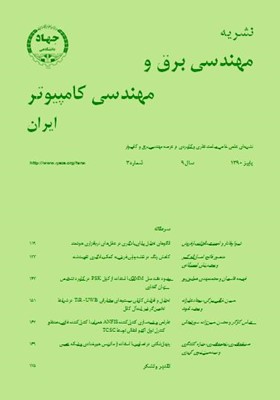بهبود دقت مدل GMM با استفاده از کرنل PSK در کاربرد تشخيص زبان گفتاري
محورهای موضوعی : مهندسی برق و کامپیوترفهیمه قاسمیان 1 * , محمدمهدی همایونپور 2
1 - دانشگاه صنعتی امیرکبیر
2 - دانشگاه صنعتی امیرکبیر
کلید واژه: تشخيص زبان کرنل دنبالهاي PSK ماشين بردار پشتيبان (SVM) مدل مخلوط گاوسي (GMM),
چکیده مقاله :
مدل مخلوط گاوسي (GMM)، روشي ساده و مؤثر براي مدلکردن آماري فضاي ويژگيهاست که بهطور گسترده در کاربرد تشخيص زبان مورد استفاده قرار گرفته و از الگوريتم بيشينهسازي اميد رياضي براي آموزش پارامترهاي اين مدل استفاده ميشود. در اين مقاله با توجه به مشکلي که در آموزش مدل GMM وجود دارد، مدلي جديد با نام PAW-GMM ارائه شده است. در اين مدل، قدرت هر مؤلفه از مدل GMMدر تمايز يک زبان از ساير زبانها، براي تعيين وزن هر مؤلفه در نظر گرفته ميشود. مدل PAW-GMM بهدليل در نظر گرفتن خواص تمايزي مؤلفههاي مخلوط گاوسي، سبب افزايش دقت سيستمهاي تشخيص زباني ميشود که از اين مدل بهعنوان جايگزين مدلGMM استفاده ميکنند. همچنين يکي از مشکلاتي که در سيستم GMM-PSK-SVMکه يکي از بهترين سيستمهاي تشخيص زبان است وجود دارد، پيچيدگي محاسباتي بالا خصوصاً با اضافهشدن تعداد زبانهاست. از اين رو سيستم UBM-PSK-SVM ارائه شده است که با ثابت نگه داشتن دقت سيستم GMM - PSK - SVM، سبب کاهش پيچيدگي محاسباتي آن شده و در نتيجه قدرت تعميم به زبانهاي بالاتر را افزايش ميدهد. آزمايشهاي صورتگرفته بر روي 4 سيستم تشخيص زبان مختلف با استفاده از دادههاي مربوط به 4 زبان انگليسي، فارسي، فرانسوي و آلماني دادگان OGI، کارايي تکنيکهاي ارائهشده را نشان ميدهد.
Gaussian Mixture Model (GMM) is a simple and effective method for statistical modeling of the feature space which is widely used in spoken language recognition systems and EM algorithm is used for training the parameters of this model. In this paper, considering the weakness of GMM models, a new model named PAW-GMM is proposed. In this model, the power of each component of GMM in discriminating one language from the others is considered for determining the weights of components. Since PAW-GMM considers the discriminating property of GMM components, it could increase the accuracy of language recognition systems. Also one of the problems of GMM-PSK-SVM which is one of the best GMM models is the high complexity especially for high number of languages. Therefore UBM-PSK-SVM is proposed that has the same accuracy as GMM-PSK-SVM but lower complexity. Experiments on four languages of OGI corpus show the efficiency of the proposed techniques.
[1] A. Ziaei, S. M. Ahadi, S. M. Mirrezaie, and H. Yeganeh, "Spoken language identification using a new sequence kernel - based SVM back - end classifier," in Proc. IEEE Int. Symp. on Signal Processing and Information Technology, pp. 324-329, Dec. 2008.
[2] M. A. Zissman, "Comparision of four approaches to automatic language identification of telephone speech," IEEE Trans. on Speech and Audio Processing, vol. 4, no. 1, pp. 31-44, Jan. 1996
[3] H. Li, B. Ma, and C. H. Lee, "A vector space modeling approach to spoken language identification," IEEE Trans. on Audio, Speech and Language Processing, vol. 15, no. 1, pp. 271-284, Jan. 2007.
[4] R. Tong, B. Ma, H. Li, and E. S. Chng, "A target oriented phonotactic front - end for spoken language recognition," IEEE Trans. on Audio, Speech and Language Processing, vol. 17, no. 7, pp. 1335-1347, Sep. 2009.
[5] P. A. Torres-Carrasquillo, E. Singer, M. A. Kohler, R. J. Greene, D. A. Reynolds, and J. A. Deller, "Approaches to language identification using gaussian mixture models and shifted delta cepstral features," in Proc. ICSLP, pp. 89-92, 2002.
[6] K. -A. Lee, C. You, H. Li, T. Kinnunen, and D. Zhu, "Characterizing speech utterances for speaker verification with sequence kernel SVM," in Proc. InterSpeech 2008, pp. 1397-1400, 2008.
[7] W. Campbell, J. Campbell, D. Reynolds, E. Singer, and P. Torres - Carrasquillo, "Support vector machines for speaker and language recognition," Comput. Speech Lang., vol. 20, no. 2-3, pp. 210-229, Jul.. 2006.
[8] W. Campbell, D. Sturim, and D. Reynolds, "Support vector machines using GMM supervectors for speaker verification," IEEE Signal Process. Lett., vol. 13, no. 5, pp. 308-311, May 2006.
[9] Z. Karam and W. Campbell, "A new kernel for SVM MLLR based speaker recognition," in Proc. InterSpeech 2007, pp. 290-293, Antwerp, Belgium, Aug. 2007.
[10] N. Dehak, P. A. Torres, D. Reynolds, and R. Dehak, "Language recognition via i-vectors and dimensionality reduction," in Proc. InterSpeech 2011, pp. 857-860, 2011.
[11] D. Matrouf, F. Verdet, M. Rouvier, J. F. Bonastre, and G. Linarès, "Modeling nuisance variabilities with factor analysis for GMM - based audio pattern classification," Computer Speech and Language, vol. 25, no. 3, pp. 481-498, Jul. 2011.
[12] J. Farinas and F. Pellegrino, "Automatic rhythm modeling for language identification," in Proc. Eurospeech, vol. 4, pp. 2539-2542, 2001.
[13] R. Tong, M. Bin, D. Zhu, H. Li, and E. S. Chng, "Integrating acoustic, prosodic and phonotactic features for spoken language identification," in Proc. IEEE Int. Conf. on Acoustics, Speech and Signal Processing, ICASSP, vol. 1, pp. 205-208, 14-19 May 2006.
[14] W. M. Campbell, E. Singer, P. A. Torres - Carrasquillo, and D. A. Reynolds, "Language recognition with support vector machines," in Proc. Odyssey: the Speaker and Language Recognition Workshop, pp. 41-44, 2004.
[15] F. Ghasemian and M. M. Homayounpour, "Towards better GMM-based acoustic modeling for spoken language identification," in Proc. ICEE, 4 pp., 2011.
[16] R. Tong, B. Ma, H. Li, and E. S. Chng, "Target-oriented phone tokenizers for spoken language recognition," in Proc. InterSpeech 2009, pp. 200-203, Apr. 2009.
[17] W. M. Campbell, "A covariance kernel for SVM language recognition," Proc. IEEE Int. Conf. on Acoustics, Speech and Signal Processing, ICASSP, pp. 4141-4144, Apr. 2008.
[18] Y. K. Muthusamy, R. A. Cole, and B. T. Oshika, "The OGI multi - language telephone speech corpus," in Proc. ICSLP 92, pp. 895-898, 1992.

